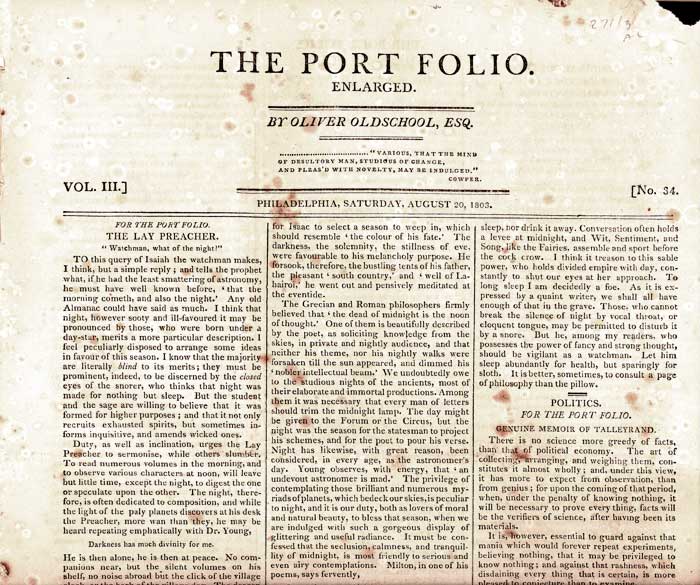Difference between revisions of "Wilson Collection: Romantic Friendships/Joseph Dennie and Roger Vose"
(Romantic friendships) |
(Romatic friendships/Joseph Dennie & Roger Vose) |
||
| (8 intermediate revisions by the same user not shown) | |||
| Line 1: | Line 1: | ||
| − | + | [[File:Oliveroldfixed.jpg]] | |
| + | |||
| + | ''(A copy of the journal, The Port Folio, 1803, | ||
| + | edited by Joseph Dennie)'' | ||
'''Romantic Friendships''' | '''Romantic Friendships''' | ||
| − | What are called romantic friendships were common in the 19th-century. These same-sex relationships were aided by the so-called social “spheres” that regulated gender roles and often kept males and females apart. | + | What are called romantic friendships were common in the 19th-century. These same-sex relationships were aided by the so-called social “spheres” that regulated gender roles and often kept males and females apart.<ref>David Deitcher, ''Dear Friends: American Photographs of Men Together, 1840-1918'' (New York: Harry N. Abrams, Inc., Publishers, 2001), 51.</ref> |
| − | |||
| − | |||
| + | Officially, romantic friendships were “pure” and chaste (not lustful or sexual), exemplifying the Victorian concept of “true love.”<ref>Deitcher, 96.</ref><ref>Jonathan Ned Katz, ''The Invention of Heterosexuality'', with a new preface (Chicago: The University of Chicago Press, 2007), 44.</ref> They allowed intense emotional, physical, and spiritual same-sex intimacy marked by fluid expressions of affection. But as historians point out, the “overlap of the romantic, erotic, and physical” may now make these vintage relationships hard to define.<ref>John D'Emilio and Estelle B. Freedman, ''Intimate Matters: A History of Sexuality in America'' (New York: Harper and Row, Publishers, 1988), 121.</ref> | ||
| + | '''Joseph Dennie and Roger Vose''' | ||
| − | [ | + | Joseph Dennie formed intense relationships with his Harvard college buddies. One close friend was Roger Vose. In 1790, Dennie wrote Vose, saying “The only wish I form is, that fortune, contenting herself with keeping us so long asunder, would now wheel about & suffer you to live & study with me at Groton [and that] for years to come one might be our table & one our bed.”<ref>The History Project, compiler, ''Improper Bostonians'' (Boston: Beacon Press, 1998), 34.</ref> Vose replied, “A prospect of resting near Dennie for life would be very agreeable. Agreeable? It would be heavenly.”<ref>History, 34.</ref> |
| − | + | Dennie edited and, as “Oliver Oldschool, Esq.,” contributed to "The Port Folio".<ref>William Warland Clapp, ''Joseph Dennie: Editor of “The Port Folio,” and Author of “The Lay Preacher”'' (Cambridge: John Wilson and Son, 1880), 33, accessed October 19, 2012, http://books.google.com/books? id=njgRAAAAYAAJ&printsec=frontcover&source=gbs_ge_summary_r&cad=0#v=onepage&q=port&f=false.</ref> Pages of that literary publication were populated with discussions about male-to-male friendship. | |
| − | |||
| − | |||
| − | |||
| − | |||
| − | + | ==''References''== | |
| + | <references /> | ||
| − | |||
| − | |||
| − | + | ==''To return to "Exhibit contents" links, click:''== | |
| + | ==[[Rich Wilson: Aspects of Queer Existence in 19th-Century America]]== | ||
| − | + | ==''See also:''== | |
| − | |||
| − | |||
| − | |||
| + | ==[[Parkman's "Romantic friendships", 1846]]== | ||
| − | + | ==[[Alexander Hamilton to John Laurens: 1779-1783]]== | |
| − | + | ==[[Beginnings: Attempting a Lesbian History Project]]== | |
| − | |||
| − | |||
Latest revision as of 11:08, 26 November 2012
(A copy of the journal, The Port Folio, 1803, edited by Joseph Dennie)
Romantic Friendships
What are called romantic friendships were common in the 19th-century. These same-sex relationships were aided by the so-called social “spheres” that regulated gender roles and often kept males and females apart.[1]
Officially, romantic friendships were “pure” and chaste (not lustful or sexual), exemplifying the Victorian concept of “true love.”[2][3] They allowed intense emotional, physical, and spiritual same-sex intimacy marked by fluid expressions of affection. But as historians point out, the “overlap of the romantic, erotic, and physical” may now make these vintage relationships hard to define.[4]
Joseph Dennie and Roger Vose
Joseph Dennie formed intense relationships with his Harvard college buddies. One close friend was Roger Vose. In 1790, Dennie wrote Vose, saying “The only wish I form is, that fortune, contenting herself with keeping us so long asunder, would now wheel about & suffer you to live & study with me at Groton [and that] for years to come one might be our table & one our bed.”[5] Vose replied, “A prospect of resting near Dennie for life would be very agreeable. Agreeable? It would be heavenly.”[6]
Dennie edited and, as “Oliver Oldschool, Esq.,” contributed to "The Port Folio".[7] Pages of that literary publication were populated with discussions about male-to-male friendship.
References
- ↑ David Deitcher, Dear Friends: American Photographs of Men Together, 1840-1918 (New York: Harry N. Abrams, Inc., Publishers, 2001), 51.
- ↑ Deitcher, 96.
- ↑ Jonathan Ned Katz, The Invention of Heterosexuality, with a new preface (Chicago: The University of Chicago Press, 2007), 44.
- ↑ John D'Emilio and Estelle B. Freedman, Intimate Matters: A History of Sexuality in America (New York: Harper and Row, Publishers, 1988), 121.
- ↑ The History Project, compiler, Improper Bostonians (Boston: Beacon Press, 1998), 34.
- ↑ History, 34.
- ↑ William Warland Clapp, Joseph Dennie: Editor of “The Port Folio,” and Author of “The Lay Preacher” (Cambridge: John Wilson and Son, 1880), 33, accessed October 19, 2012, http://books.google.com/books? id=njgRAAAAYAAJ&printsec=frontcover&source=gbs_ge_summary_r&cad=0#v=onepage&q=port&f=false.
